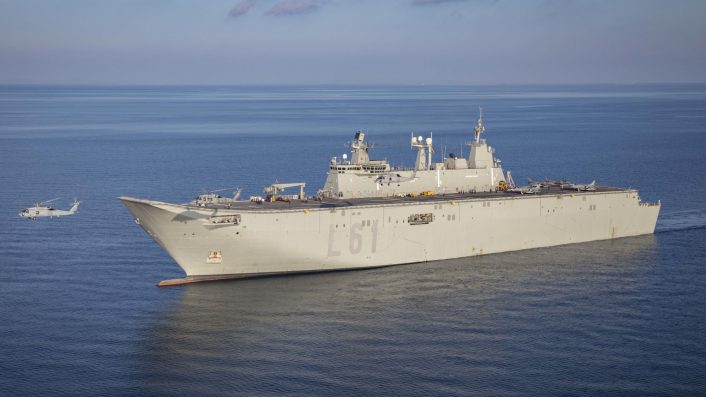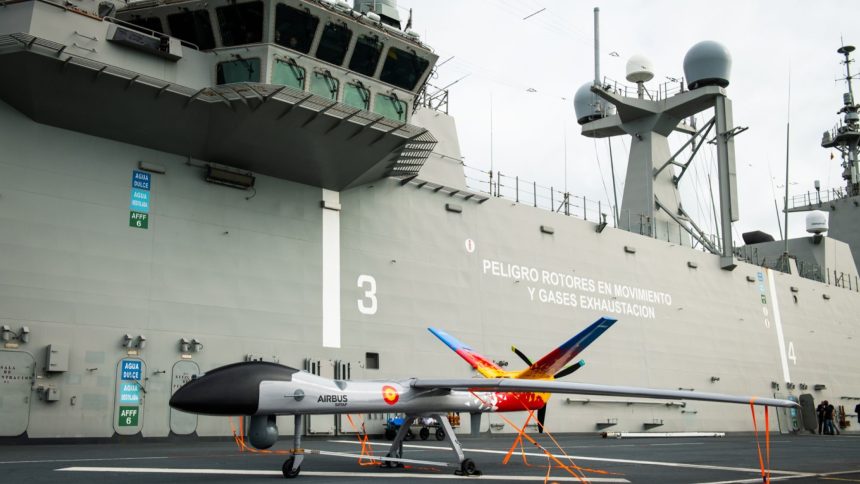The integration of SIRTAP of the Juan Carlos I will focus on command and control, combat system integration and navigation support, including take-off and landing operations.
European defense and aerospace major Airbus has announced the signing of an agreement with Spanish state-owned shipbuilder Navantia to explore the integration of Airbus’ SIRTAP UAS (Unmanned Aerial System) on the Spanish Navy’s flagship, the Juan Carlos I multi-purpose aircraft carrier – Landing Helicopter Dock (LHD). The ship is the Armada Española’s (Spanish Navy) sole aircraft carrier and is equipped with a ski-jump to support AV-8B Harrier II’s flight operations.
Airbus also released pictures of the SIRTAP secured on various spots along the Juan Carlos’s flight deck, while in port. The system shown in the photos is possibly a full-sized mockup, since the platform is still under development.
“Airbus and Navantia sign an agreement to explore the integration of SIRTAP into the Spanish Navy Juan Carlos I flagship. This aims to be the first step to guarantee interoperability of SIRTAP with the rest of the systems of the carrier, such as the SCOMBA (Sistema de COMbate de Buques de la Armada) combat management system,” Airbus Defence and Space said in the statement.
As the Airbus announcement noted, the integration activities will focus on three pillars to be explored, including the command and control, combat system integration and navigation support, with the latter also including take-off and landing operations.
Airbus and @NavantiaOficial sign an agreement to explore the integration of #SIRTAP into the Spanish Navy Juan Carlos I flagship.
This aims to be the first step to guarantee the interoperability of SIRTAP with the rest of systems of the carrier, such as the SCOMBA combat system.… pic.twitter.com/iCka8Ccdjr
— Airbus Defence (@AirbusDefence) January 28, 2025
The agreement
“This joint effort seeks to achieve a fully integrated system, ensuring complete compatibility between SIRTAP and Juan Carlos I carrier, increasing its mission capabilities, operational flexibility, and the overall effectiveness of both platforms in diverse operational scenarios,” said Airbus describing the work to be done. “This agreement could set the path to offer the Spanish Navy with additional capabilities developed in Spain, strengthening the national industry in the benefit of its strategic sovereignty.”
While Navantia also confirmed the development, there was no comment on the matter from either the Spanish Defense Ministry or the Navy. On a different note, the Spanish Navy did announce on Jan. 25, 2025, that it would deploy the Expeditionary Combat Task Group “Dédalo” in Mediterranean waters “up to three times” in 2025 “to express Spain’s firm commitment to the Alliance’s Deterrence and Defense Policy.” This confirms the importance of the aircraft carriers in NATO navies.
The statement added that the Task Group will be made up of “an LHD-type amphibious ship and/or Landing Platform Dock with a reinforced Marine Corps battalion and a complete role-2 medical unit, F100 and FFG frigates, fixed wing aircraft, tactical transport helicopters and an auxiliary oiler and replenishment ship.”

SIRTAP on Juan Carlos I
It is not clear what kind of launch or recovery method will be used to operate the Airbus SIRTAP on the Juan Carlos I. Also, neither Airbus, Navantia or the Spanish government have given a roadmap or a timeline for the integration program. It also remains to be seen whether the results of the studies will inform future Spanish Navy’s UAV, aircraft, helicopter or ship-building plans.
Regardless, Spain is not the only country to explore operating drones from their carriers to offer a different strike and surveillance capability, as seen in the direction in which Turkey is heading with its TCG Anadolu carrier.However, while UAVs are relatively less complicated aircraft, their operation from carriers and ships does require a different set of logistical and technical processes.
These include crew familiarization, making space for the drone, its maintenance equipment and operational teams, and fusing the control stations within the ship’s bridge, CIC and radar communications systems. Standard movement of crew and machinery and flight procedures have to be either slightly or significantly changed when adopting a new aircraft on an aircraft carrier.
Nos encanta ver nuestro #UAS táctico de altas prestaciones #SIRTAP en el stand del @EjercitoAire en @FEINDEF_. #Airbus y el gobierno de España 🇪🇸 potenciarán juntos la industria aeroespacial nacional y capacidad en los no tripulados, con un programa end-to-end Made in #Spain. pic.twitter.com/yYzuKJEgk3
— Airbus Defence (@AirbusDefence) May 17, 2023
According to Airbus, the SIRTAP is a “high-end tactical unmanned aircraft system.” Spain became a part of the program in 2023 and is set to acquire nine systems – with a ground control station and three aircraft each. Needless to say, Madrid might sign on for more SIRTAPs if the exploration study is positive.
The SIRTAP is primarily an ISR (Intelligence, Surveillance and Reconnaissance) platform, considered as an “all-weather”, “harsh environment” UAV, with an endurance of more than 20 hours and an operational altitude of over 20,000 feet. The company added that it will be certified by Spanish military airworthiness authorities to fly in segregated airspace.
The two primary payloads are an EO/IR (Electro-Optical/Infrared) turret under the chin and a multi-mission radar, according to Airbus. SIRTAP can also undertake force protection missions with guided weapons on the four underwing hardpoints in a maritime environment. Other capabilities include electronic warfare, with the integration of SIGINT, ELINT and COMINT sensors.
Juan Carlos I amphibious assault helicopter carrier
The Juan Carlos I was commissioned into the Spanish Navy (Armada Española) on Sep. 30, 2010, and is capable of operating diverse aircraft, including CH-47F Chinook, NH90TTH, and SH-60B/F Seahawk helicopters, as well as the V/STOL (Vertical/Short Take-Off and Landing) EAV-8B+ Matador (equivalent to the USMC AV-8B+ Harrier II jets). Given increasing NATO military needs and capability enhancements, the Juan Carlos I is likely to also be prepared to operate NATO F-35B Lightning IIs or other American aircraft.
El buque portaaeronaves #JuanCarlosI se ha hecho hoy a la mar en demanda del puerto de #Valencia, donde relevará al buque de asalto anfibio #Galicia. #SomosLaArmada⚓🇪🇸 pic.twitter.com/0kaiMzN3qY
— Armada (@Armada_esp) November 15, 2024
The Juan Carlos has a flight deck of 202 meters (663 feet) with a ski-jump at the end of the deck. The Spanish Navy says that it can carry up to 30 medium and heavy helicopters for amphibious operations or 10/12 F-35B or EAV-8B+ and a similar number of helicopters in her aircraft carrier configuration. It can also carry heavy-class helicopters like the CH-47 Chinook and the V-22 Osprey.
Madrid was reported in Nov. 2023 to have declined the F-35 and instead focused on the Eurofighter Typhoon, under the Halcon I and Halcon II programs, to replace its older EF/18 and EF-18B Hornets. The F-35B was considered as the possible replacement for the EAV-8Bs.
The obligation to have NATO and U.S. aircraft compatible systems remains even without the F-35s. This is especially considering the fact that the Turkish Navy’s helicopter, drone carrier and amphibious assault ship, the TCG Anadolu, which is based on the Juan Carlos I design, saw a U.S. Marine Corps MV-22B Osprey land on it for the first time on Aug. 15, 2024.
Reports in 2015 said that its design at the time catered for operating F-35Bs as well, until Turkey was expelled from the F-35 program over its purchase of the Russian S-400 air defense system. The TCG Anadolu ship itself was constructed by a Spanish-Turkish consortium of Sedef-Navantia.









